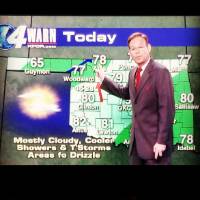Summary
In this lesson, students will look at phenomena using a weather simulation in order to learn more about descriptive statistics and measures of central tendency. The lesson focuses on extreme weather in different parts of the United States.
Essential Question(s)
How can we use measures of central tendency to understand weather phenomena?
Snapshot
Engage
Students explore a tool to familiarize themselves with weather simulations.
Explore
Students explore how to find measures of central tendency (mean, median, mode) and, other descriptive statistics (range, minima, maxima).
Explain
Through discussion, students explain how to find each of the statistical measures.
Extend
Students return to the weather simulation to apply their statistical analysis to the 2019 tornado outbreak in the Southeast United States.
Evaluate
Students complete a 3-2-1 activity to reinforce and share their learning.
Materials
Chromebooks, laptops, or tablets with internet access
Pens and pencils
I Notice, I Wonder handout (attached)
Weather Phenomena Explore Activity handout (attached)
Weather Phenomena Extend Activity handout (attached)
Engage
Ask students to take out their internet accessible device (laptop, Chromebook, etc.) and navigate to the weather map simulation.
Give students a few minutes to simply explore the weather map. Next, have students explore different overlays within the "earth" menu found at the bottom of the page.
As students are exploring, have them complete an I Notice, I Wonder activity. Pass out copies of the I Notice, I Wonder chart or have students make their own by labeling the left half of a sheet of paper "I Notice" and the right half "I Wonder." As students explore, have them jot down different interesting aspects of the model that they notice. To help spur students' curiosities, ask them to write down things they are wondering about the model.
Once students have had 5 to 10 minutes to explore, ask them to pause and share some of what they notice and wonder. Start with a few "I notice" statements and then move to a few "I wonder" statements.
Explore
Distribute copies of the attached Weather Phenomena Explore handout. Ask students to work with a partner and instruct the pairs to choose whether they will explore the bomb cyclone or Hurricane Harvey. Have pairs follow the directions in the handout and use the weather simulation web page to complete the remainder of the Explore activity.
Continuing to use their handout, ask students to complete the activities in the Calculating Measures of Central Tendency section to explore the central tendency (mean, median, and mode) of their data.
Explain
Ask pairs of students to form groups of four with another pair.
Ask students to discuss the following questions:
How did you go about finding the mean? When do you think this would be a helpful measure?
How did you go about finding the median? When do you think this would be a helpful measure?
How did you go about finding the mode? When do you think this would be a helpful measure?
Why do you think it is helpful for us to know about measures of central tendency when working with weather data?
Can you think of other instances when you might need to find the mean, median, or mode of a data set?
Once students have answered the questions above, ask them to think about the following questions:
What do you think the maximum value would be in your data set?
What do you think the minimum value would be in your data set?
Can you calculate the range of your data set? (This would be the difference in the minimum and maximum.)
Extend
Share with students that as an activity to extend their learning, they will be recording data associated with the 2019 tornado outbreak in the southeastern part of the United States.
Ask students to return to their original partner and go back to the weather simulation web page. Distribute the attached Weather Phenomena Extend handout.
Have students work through the handout with their partners, discussing each question along the way. Make sure to be available to assist students as questions arise.
Once students have completed the Extend activity, have them close their laptops and move to the Evaluate activity.
Evaluate
Using the 3-2-1 instructional strategy, ask students to get out a sheet of paper and individually reflect on the following questions:
3. What are three things you learned today that you didn't know before?
2. What are two ways you can use statistics to make sense of the world around you?
1. What is one thing you're now curious about?
Ask students to turn in their reflection before they leave. Use the questions to further discuss students' curiosities in the coming days.
Resources
Beccario, C. (2019). Earth: A visualization of global weather conditions. Retrieved from https://earth.nullschool.net/about.html
K20 Center. (n.d.). 3-2-1. Strategies. https://learn.k20center.ou.edu/strategy/d9908066f654727934df7bf4f5059a7b
K20 Center. (n.d.). I Notice, I Wonder. Strategies. https://learn.k20center.ou.edu/strategy/d9908066f654727934df7bf4f507d1a7


